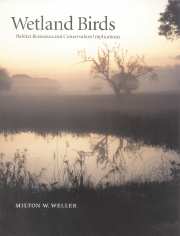Book contents
- Frontmatter
- Contents
- List of plates
- Preface
- Acknowledgments
- 1 Introduction
- 2 Wetlands: what, where, and why
- 3 Major groups of birds that use wetlands
- 4 Water and other resource influences
- 5 Foods, feeding tactics, strategies, and guilds
- 6 Bird mobility and wetland predictability
- 7 Other behavioral and physical influences on wetland living
- 8 Spatial and structural patterns
- 9 Habitat dynamics: water, plant succession, and time
- 10 Population consequences of wetland abundance and quality
- 11 How birds influence wetlands
- 12 Conservation implications
- 13 Measures of bird habitat use and quality
- 14 Current status and some conservation problems
- 15 Conservation and management strategies
- 16 Outlook
- 17 Epilogue
- Appendix 1 Scientific names of birds and bird groups
- Appendix 2 Scientific names of animals and animal groups other than birds
- Appendix 3 Scientific names of plants and plant groups
- Index of birds and bird groups
- Subject index
11 - How birds influence wetlands
Published online by Cambridge University Press: 02 October 2009
- Frontmatter
- Contents
- List of plates
- Preface
- Acknowledgments
- 1 Introduction
- 2 Wetlands: what, where, and why
- 3 Major groups of birds that use wetlands
- 4 Water and other resource influences
- 5 Foods, feeding tactics, strategies, and guilds
- 6 Bird mobility and wetland predictability
- 7 Other behavioral and physical influences on wetland living
- 8 Spatial and structural patterns
- 9 Habitat dynamics: water, plant succession, and time
- 10 Population consequences of wetland abundance and quality
- 11 How birds influence wetlands
- 12 Conservation implications
- 13 Measures of bird habitat use and quality
- 14 Current status and some conservation problems
- 15 Conservation and management strategies
- 16 Outlook
- 17 Epilogue
- Appendix 1 Scientific names of birds and bird groups
- Appendix 2 Scientific names of animals and animal groups other than birds
- Appendix 3 Scientific names of plants and plant groups
- Index of birds and bird groups
- Subject index
Summary
Although our major goal throughout the book has been to relate bird habitat use to wetland resources and features, birds that can directly affect a wetland ecosystem by their influence on vegetation and thereby bird habitat have an impact on other birds directly or alter ecosystem processes that may induce change within the entire system (Table 11.1).
Because of their mobility, birds facilitate movement of invertebrates to established wetlands that have lost their population via drought (Swanson 1984), as all invertebrates do not have eggs that can survive long periods without water (Wiggins, MacKay and Smith 1980). Birds also transport invertebrate eggs to newly created wetlands such as strip-mine ponds or river-formed wetlands. Common herbivorous crustaceans like amphipods have been especially prominent in studies of the plumage of hunter-killed or live waterfowl in both Europe and North America, but snails, snail eggs, and other macrocrustaceans have also been noted in plumage. One cannot wade in wetlands without experiencing invertebrates and seeds clinging to boots, so it is no surprise that birds (and also beavers and muskrats) carry them as well. Plant materials such as seeds and foliage of submergent plants are commonly found in or on the plumage of herbivorous ducks and coots. One study reported seeds of 12 saltmarsh plants, most of which had special adhesive devices or systems, carried by ducks (Vivian-Smith and Stiles 1994). This helps to explain a gradual increase in richness that occurs over time in wetland developed on strip-mined lands, where plant “seed banks” are minimal (McKnight, 1992). In such cases, wetland seed banks from 5- to 7-year-old ponds are commonly used to establish vegetation in newly created wetlands.
- Type
- Chapter
- Information
- Wetland BirdsHabitat Resources and Conservation Implications, pp. 183 - 188Publisher: Cambridge University PressPrint publication year: 1999
- 1
- Cited by



